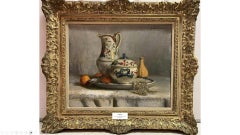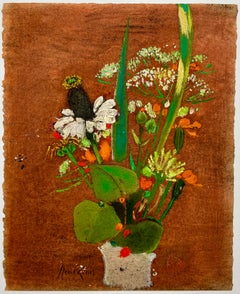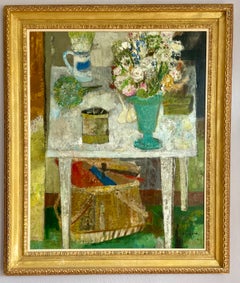LOUIS DE MONTIGNACQ Paintings
to
2
1
Overall Width
to
Overall Height
to
1
2
2
1
1
2
1
3
3
2
3
Still Life With Cherries, Oil on canvas signed lower right
Located in PARIS, FR
Pierre PALUÉ (1920-2005), Still life with cherries, oil on canvas signed lower right, 44.5 x 59 cm, 65 x 80 cm with the frame.
Pierre Palué was born in Bordeaux on May 13, 1920. In ...
Category
1980s Modern Still-life Paintings
Materials
Oil
Vols aimés, Arapongas, oil on canvas, 1984, 146 x 104 cm, signed and dated
Located in PARIS, FR
Charles GIAI-GISCHIA (born in 1956), Loved Flights, Araponga, oil on canvas, signed, titled and dated 1984 at the bottom, 146 x 104 cm. Excellent condition.
Excerpt from his biogra...
Category
1980s Contemporary Abstract Paintings
Materials
Oil
Still life with a pearl necklace, oil on canvas
Located in PARIS, FR
Gustave DURAND (1863 – 1938), Still life with a pearl necklace, late 19th century – early 20th century, oil on canvas, signed upper right, 60 x 73 cm
Good general condition of the c...
Category
Late 19th Century French School Still-life Paintings
Materials
Oil
Related Items
“bouquet au fons rouille” / bouquet with rusty frons
By René Genis
Located in Berlin, MD
Rene Genis (French 1922-2004) “bouquet au fons rouille” / bouquet with rusty frons. Oil on woven paper stock with deckled edges laid down on matt board. Signed lower right, titled v...
Category
Mid-20th Century French School Still-life Paintings
Materials
Oil, Handmade Paper
$825
H 23.875 in W 16 in D 0.125 in
"Nature Morte à la table blau(?)" / Still Life at the (?) Table
By Guy Bardone
Located in Berlin, MD
Guy Bardone (1927 - 2015, French) "Nature Morte à la Table Blau (?)" / Still Life at the (?) Table. Oil on canvas with a lovely frame surrounding. The picture in greens and browns...
Category
Mid-20th Century French School Still-life Paintings
Materials
Canvas, Oil
$9,960
H 48 in W 40.5 in D 2.75 in
Still Life with Pitcher (Nature morte au pichet)
By Duilio Barnabe
Located in Chicago, IL
This painting is signed and dated by Barnabè in the lower right. Barnabè's still-lives of simple everyday objects such as water pitchers, coffee cups, vases and bowls are painted in ...
Category
Mid-20th Century Modern Still-life Paintings
Materials
Canvas, Oil
Small bouquet of buttercups, oil painting by Françoise Juvin
Located in Montfort l’Amaury, FR
Françoise Juvin - Small bouquet of buttercups
Reference number FJ106
Framed with a black wood floated frame.
24,5 x 31,5 cm frame included (19 x 26 cm ...
Category
1980s French School Interior Paintings
Materials
Oil
$1,324 Sale Price
20% Off
H 7.49 in W 10.24 in D 1.38 in
Autumn Flowers Post Impressionist
Located in Greenwich, CT
Incredibly beautiful paint surface! Incredible French Gilt frame.
René Demeurisse began his exhibition career at the Salon de la Societé Nationale de...
Category
1920s French School Still-life Paintings
Materials
Canvas, Oil
Still Life on a Table - Oil Painting on Canvas - 20th Century
Located in Roma, IT
Still Life on a Table is an original oil painting on canvas realized in the 20th Century.
Good conditions (the painting has been restored in some parts).
Frame included (83x108 cm).
Category
20th Century Modern Figurative Paintings
Materials
Canvas, Oil
$3,782
H 27.17 in W 35.44 in D 1.19 in
Bouquet Champêtre
By Pierre Boncompain
Located in Austin, TX
Waterline Fine Art, Austin, TX is pleased to present the following work:
Oil on canvas. Signed lower right; titled verso.
36.25 x 28.75 in.
44.75 x 37.5 in. (framed)
Custom framed...
Category
Late 20th Century French School Still-life Paintings
Materials
Canvas, Oil
Antique French Modernist Signed Sunflower Still Life Framed Rare Oil Painting
Located in Buffalo, NY
Vintage French modernist still life oil painting. Oil on canvas. Framed. Signed. Measuring: 35 by 20 inches overall. In excellent original condition. Handsomely framed in a modern...
Category
1950s Modern Still-life Paintings
Materials
Canvas, Oil
$975
H 35 in W 20 in D 2 in
Antique American Realist Framed Flower Jug Still Life Oil Painting Yellow Roses
Located in Buffalo, NY
Very impressive antique American flower still life oil painting.
Stunning and unique original frame.
Oil on canvas.
Painting size, 18H by 14L.
Exceptional quality. Signe...
Category
Late 19th Century Modern Still-life Paintings
Materials
Oil, Canvas
$951 Sale Price
20% Off
H 26 in W 22 in D 2 in
Nature morte au moulin à café/Still life with coffee grinder
Located in Montfort l’Amaury, FR
Reference number F372
Framed with an ebony color wood floated frame.
49 x 74 cm frame included (29 x 54 cm without frame)
This work is painted with oil on a paper that is mounted on ...
Category
1980s French School Still-life Paintings
Materials
Oil
$1,913 Sale Price
20% Off
H 49 in W 74 in D 5 in
Still Life - Oil on Canvas - Late 19th century
Located in Roma, IT
Still Life is an artwork realized by an unknown artist in the late 19th Century.
Oil on Canvas Mounted on Board.
Original wooden frame.
18 x 13 cm.
Good conditions
Category
Late 19th Century Modern Still-life Paintings
Materials
Board, Canvas, Oil
Still life with a red book, oil painting by Pierre Coquet
Located in Montfort l’Amaury, FR
Pierre Coquet (1926-2021)
Still life with a red book
Reference number F285
46 x 55 cm (not framed)
This work is painted with oil on a canvas. There is a stamp of the signature in the...
Category
1990s French School Figurative Paintings
Materials
Canvas, Oil
$1,513 Sale Price
39% Off
H 18.12 in W 21.66 in D 0.79 in


